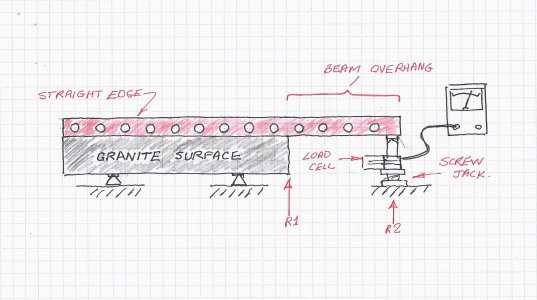- Joined
- May 27, 2016
- Messages
- 3,479
The granite 18 x 18 in inches. The diagonal is about 25.4 inches. The need is for a straightedge 36 inches long. A good granite that size costs a bundle, and takes up lots of room in a small shop. Also, I already have the 18 x 18.
I get it that spotting 2/3 of the length is likely to get messed up by the overhang, and it gets mad confusing if one then spots it by shifting the work along to get at the 2/3 from the other end. What if there was a high spot near the overhang end? That would produce a whole new spotting pattern over the 2/3 already done.
I thought there may be a strategy, but also perhaps that this problem already has a well proven strategy that I just don't know about yet.

1. Null the overhang.
I am thinking to eliminate the overhang bow effect using something like in the sketch. The jack is set to carry half the weight of the overhang. This could at least allow a spotting pattern on the tested 2/3, but not any hinging moves.
2. Getting at the overhang end
The next move is to turn the work around to have the overhang now included in the 2/3, but resolutely ignore all results other than those from the previous overhang, plus a very little extra. Work only on what used to be the overhang. If there was a high spot, it will be seen. If there was a local low, then that too will be seen. This can inform a strategy on what to do about the initial 2/3, and how to bring it all into a common line.
3. Getting a single spotting result over the whole work
Suppose the condition of the overhang was (extreme case) all a bit low, needing the entire initial 2/3 to be scraped down to meet it. This too might be done by looking for a spotting pattern that has a middle third that repeats, even though it now has the initial overhang shared over the plate. I even thought one may be able to check with a 2-colour spotting, to see if one overlays the other in the middle third.
All of the above is just my first attempt at a plan. If experienced folk here say it is doomed, then plan B may be to start saving up for a bigger granite. Of course, it may be that a load cell and all that stuff is just not needed, and there is already a well know work-around. I sure hope so !
I get it that spotting 2/3 of the length is likely to get messed up by the overhang, and it gets mad confusing if one then spots it by shifting the work along to get at the 2/3 from the other end. What if there was a high spot near the overhang end? That would produce a whole new spotting pattern over the 2/3 already done.
I thought there may be a strategy, but also perhaps that this problem already has a well proven strategy that I just don't know about yet.

1. Null the overhang.
I am thinking to eliminate the overhang bow effect using something like in the sketch. The jack is set to carry half the weight of the overhang. This could at least allow a spotting pattern on the tested 2/3, but not any hinging moves.
2. Getting at the overhang end
The next move is to turn the work around to have the overhang now included in the 2/3, but resolutely ignore all results other than those from the previous overhang, plus a very little extra. Work only on what used to be the overhang. If there was a high spot, it will be seen. If there was a local low, then that too will be seen. This can inform a strategy on what to do about the initial 2/3, and how to bring it all into a common line.
3. Getting a single spotting result over the whole work
Suppose the condition of the overhang was (extreme case) all a bit low, needing the entire initial 2/3 to be scraped down to meet it. This too might be done by looking for a spotting pattern that has a middle third that repeats, even though it now has the initial overhang shared over the plate. I even thought one may be able to check with a 2-colour spotting, to see if one overlays the other in the middle third.
All of the above is just my first attempt at a plan. If experienced folk here say it is doomed, then plan B may be to start saving up for a bigger granite. Of course, it may be that a load cell and all that stuff is just not needed, and there is already a well know work-around. I sure hope so !
Last edited:
